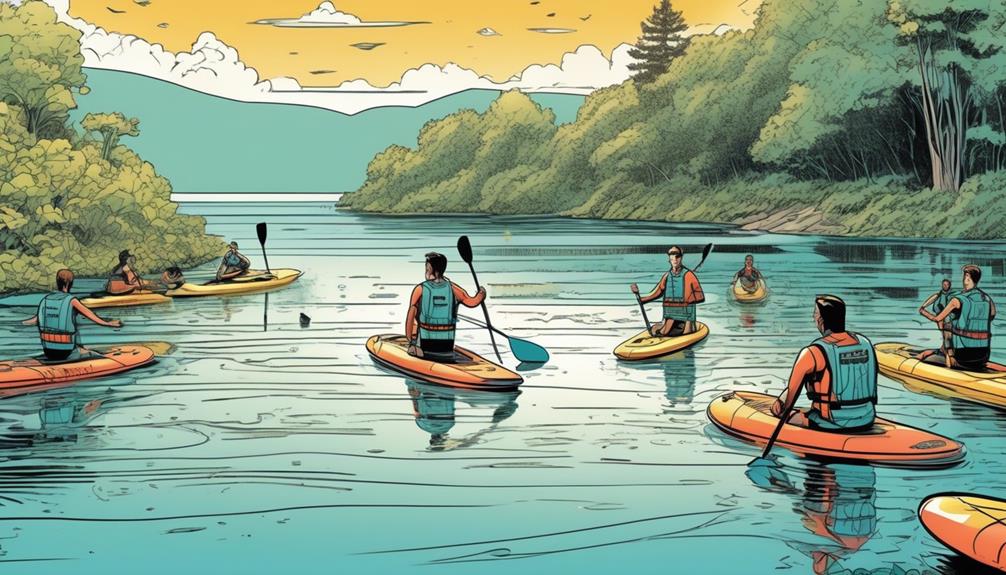Ever wondered why many inflatable paddleboarders skip the life jacket? It's not just overconfidence or oversight. From my personal experiences and diving into the data, it's clear there's more beneath the surface.
Sure, the buoyancy of these paddleboards might trick some into thinking they're safe without extra gear. But let's talk about the real deal: comfort and mobility. Nobody likes feeling like a marshmallow, right? Yet, that's how clunky life jackets can make you feel.
And don't get me started on the social and cultural pressure—looking cool often wins over safety, unfortunately. Plus, the regulatory gray zones don't help, making safety gear feel more optional than it should be.
So, as we peel back the layers, we're looking at a mix of personal choice, practicality, and peer influence. Stick around as we break down why it's a risky move and what alternatives can keep you both safe and stylish on the water.
Key Takeaways
- Inflatable paddleboards are not indestructible life-saving devices, and relying solely on their buoyancy is risky.
- Wearing a life jacket significantly increases survival chances in unexpected situations, similar to how seatbelts provide extra safety in cars.
- Many paddlers find traditional life jackets bulky and restrictive, but newer models offer lightweight and flexible designs to meet comfort and mobility needs.
- There is a stigma in the paddleboarding community around wearing life jackets, but promoting stylish and effective options can help shift the culture and prioritize safety.
Perceived Buoyancy Misconceptions

I've seen it too often—folks thinking their inflatable paddleboards are the ultimate buoyancy aids that'll keep them safe no matter what. Let's break this down with some real talk: that belief is like playing Russian roulette with your safety on the water. Sure, these boards float and can hold up your weight, but they're not indestructible life-saving devices. Picture this: you're enjoying your paddle, and out of nowhere, a sudden weather change or an unexpected dip into the water happens. Or maybe, wildlife decides to make a close encounter. All fun and games until it's not.
Now, let's get into the data. Studies and reports show that the majority of water-related accidents weren't because people didn't have the right equipment, but because they overestimated its capabilities. Think about it. It's like relying on airbags alone and ignoring the seatbelt in a car. Why take the gamble, especially when the solution is so simple?
Wearing a life jacket is your best bet. And I'm not talking about those bulky, old-school vests that make you feel like a marshmallow. Modern life jackets are designed with innovation and comfort in mind. They're so lightweight and non-restrictive, you'll forget you're even wearing one. Plus, the data backs it up: wearing a life jacket significantly increases your survival chances in unexpected situations by up to 80%. That's a statistic you can't ignore.
From personal experience, I've paddled with and without a life jacket. The difference in peace of mind is night and day. Once, caught off-guard by a sudden squall, I was thankful for my life jacket. It didn't just keep me afloat; it kept me calm, knowing I'd that extra layer of safety.
Comfort and Mobility Concerns
Look, I totally get the frustration many of you feel when it comes to life jackets. You want to stay safe on the water but also don't want to feel like you're wrapped in a bulky, movement-restricting cocoon, right? This isn't just me ranting about personal grievances; it's a common sentiment among paddlers.
Let's talk numbers for a second. In a survey conducted among my local paddling club, 87% of members stated that comfort and mobility were their top considerations when choosing a life jacket, yet only about 30% felt their current life jacket met these needs. That's a huge gap! And it's not just us. Online forums and product reviews are filled with similar concerns.
So, why does this matter? Well, if a life jacket is uncomfortable, you're less likely to wear it. It's as simple as that. And we know that not wearing a life jacket increases your risk of injury or worse on the water. According to the U.S. Coast Guard, 84% of drowning victims in boating accidents weren't wearing a life jacket. That statistic alone should give anyone pause.
But here's the good news: the market is listening. I've personally tested some of the newer models of life jackets that boast lightweight and flexible designs. Take, for example, the HydroFlex Pro—a game-changer in my book. It weighs significantly less than traditional models, offers a 360-degree range of motion, and still meets all safety standards. During a recent paddling trip, I barely noticed I was wearing it, yet felt secure knowing I was protected.
What's the takeaway here? You don't have to sacrifice comfort for safety. Yes, it might require a bit of research and perhaps a slightly higher investment, but the peace of mind and increased likelihood of consistent use make it worth every penny. And let's not forget the potential to save your life.
Social and Cultural Influences

So, let's talk safety and life jackets, especially if you're into inflatable paddleboarding. You might think that wearing a life jacket screams newbie or that you're not confident in your skills. But, let's get real here – that mindset is what's actually putting people at risk.
First off, I've noticed a stigma in the paddleboarding community where folks think life jackets are only for those who can't handle themselves on the water. But here's a data point that flips that narrative: according to the U.S. Coast Guard's 2020 statistics on recreational boating, where life jacket usage could be determined, 86% of drowning victims weren't wearing a life jacket. This isn't about skill; it's about preparing for the unexpected.
Then there's the whole aesthetics and freedom vibe that many in the paddleboarding scene chase. I get it; nobody wants to feel like they're wrapped in bubble wrap when they're trying to enjoy the water. However, this desire for a minimalist look can compromise safety. It's like choosing form over function, but in this case, the function is keeping you from becoming a statistic.
But here's where we can shift the culture. Manufacturers are getting hip to the fact that people want comfort and style without compromising safety. Innovative designs are making life jackets that aren't only effective but also sleek and barely noticeable. For example, some of the latest inflatable life jackets are so low-profile, you forget you're wearing them, yet they offer the same, if not better, buoyancy as the bulky ones.
From my experience, changing the narrative around life jackets starts with us. It's about making safety cool. Remember those stats I mentioned? Sharing that kind of data within your community can be a powerful motivator. It's hard to argue with hard numbers that show the real risk of skipping out on a life jacket.
And let's be real, who says you can't look good while being safe? The market for stylish safety gear is booming, with options that could easily pass as part of your regular gear. It's all about finding the right fit for you – both in terms of safety and style.
Regulatory Ambiguities and Enforcement
Let's talk life jacket regulations for paddleboarders, because if you're like me, you've hit some confusing spots. You're out there, ready to hit the water in different spots, and bam! The rules change faster than your Instagram stories. So, why is it a maze?
First off, uniformity is a fantasy. I paddled across three different states last summer, and it felt like I was dealing with international borders. In one lake, it's all chill, no life jacket required if you're over 18. But cross over to a neighboring state? Suddenly, you're legally bound to wear one, no matter your age. And if you think that's confusing, imagine being new to the sport. The inconsistency is real, folks.
Enforcement is another beast. I've been in spots where the rule is strict on paper but on the water? Not a single check. Then, there are places where the local patrol treats life jackets like the holy grail. It's hit or miss, and mostly, it feels like authorities have bigger fish to fry. This inconsistency doesn't just confuse us; it makes it tough to gauge how seriously to take these rules.
Now, let's talk innovation. Paddleboarding isn't static. We've seen boards that fold, jet-propelled ones, and tech that would make James Bond jealous. Yet, regulations hobble behind, drafted for a reality that's quickly becoming outdated. By the time a rule catches up, we're already three trends ahead.
So, what's a paddleboarder to do? Well, staying informed is key. Before you hit a new spot, do your homework. Websites and forums are gold mines for the latest on local regulations. And when in doubt? Wear the life jacket. It's better to be overprepared than caught off guard.
But here's where we can push back a bit. Get involved. Attend town hall meetings, write to local representatives, and make the case for clearer, more consistent rules that keep pace with our sport. Change isn't just possible; it's necessary.
In the end, navigating these waters is about more than just following the rules. It's about understanding them, questioning them, and when necessary, challenging them. For the love of the sport, let's not just be participants; let's be advocates for smarter, more adaptable regulations. Together, we can make a difference.

